



Getting ready to disembark
Optimistic driver in Wales
14th century Weobley Castle




and the rather interesting roads
we encountered
The third picture shows the
dilemma of the narrow roads
Diary/Photo Journal
Week of March 22, 2009
This week started early in Rosslare, Ireland as just after sunrise, we jumped on the ferry to get us back to Great Britain. Yet another beautiful day and a smooth cruise across the channel and we were landed firmly in beautifully quaint and cozy Wales.
Now, before we journey into Wales, you have to be introduced to the Welsh language. If you savour fantasy books such as "Lord of the Rings" or even "Harry Potter" you will realize where some of the names for the villages come from and from where some "elf" language derives. Towns such as 'Trefynwy', 'Merthyr Tydfil', 'Caerfyddin' and 'Hwlffordd' or places named 'Aberystwyth' and 'Gardd Fotaneg Genedlaethol Cymru' (National Botanic Garden of Wales) cross your eyes and tie up your tongue.
Once we were settled on the road in Wales, we decided to
check out this little peninsula that promised breathtaking views and a bit of
surfing. The Gower Peninsula did not disappoint as we wound through mazey
roads rimmed in high hedges just on the verge of taking on their full bloom.
What looked to be a short jaunt pleasantly turned out to be a two hour affair.
Making our way to Rhosilli, we parked and followed the other sun worshippers and walked along an unfenced, non barricaded, wide open point of land out to a tip of the peninsula, steeply high above the ocean. For two hours at low tide, the coastal officials will let you walk along the newly exposed rock strip that gives you dry access to the nearby island inhabited by several different types of birds. Unfortunately, we missed that window, but the view was no less stunning.
On the way to where we planned to take up temporary residence for the night, we found an ancient Roman site called the Caerleon Roman Fortress. It was built circa AD 75 and the immense amphitheater has been carefully excavated. Caerleon was one of three legionary bases built for the Roman troops and its excavated ruins still give you a glimpse of what the site must have looked like almost 2,000 years ago.
Our long day over with, we found a wonderful little inn in Monmouth called the "Punch House" that was built a few hundred years ago and seems to not have changed. With dizzily sloping floors and skull-cracking low door frames we immediately fell in love with the place.
We were again off early so we could take advantage of the many places we wanted to visit during the day. Our first stop at the Tintern Abbey was quite amazing as this mostly intact ruin (sans roof) was quite astonishing in its size and construction.
From there, we followed the Wye River down to Chepstow so we could manage a glimpse at the Chepstow Castle, built in 1067 (almost 1,000 years ago!). This massive riverside fortress was so big that we had to walk all the way to England to get a good and complete view of the structure. Of course, that just meant our walking over a bridge as we were on the border of Wales and England, but the castle was no less impressive.
    |
Crossing over from Wales
to England Chepstow Castle (built in 1067) Our walk around the area |
 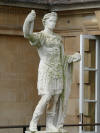 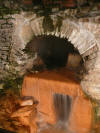 |
On the path to the baths in Bath Roman relics still Thermal waters |
Bath, a city aptly named for its famed thermal baths, was our next stop on the day. The Romans treasured this area between the 1st and 4th centuries, building their spas and extensive bath complex around one of the three large thermal pools. As alterations to the city have taken place, these almost 2,000 year old spa temples are being rediscovered in purposeful excavations and reborn for the enjoyment of the present occupants (and of course, tourists).
We took our time wandering around the various baths and with some of the "exhibits" exposing the now underground (or rather, under-street) temples, we got quite an extensive look at how the Romans built this special place.
If the awe of the 2,000 year old baths was not enough, we walked around the city a bit to soak up a little more history, albeit more recent. The Bath Abbey (built in the 16th century) was, like so many other Abbeys, quite beautiful; however, what made it more interesting was the flooding of school children within the square adjoining the Abbey. You could not hear yourself think for all the amusing laughter and chatter of the children.
In addition, I had a place in mind that I wanted to take a peek at and with the invaluable help of my GPS (Gerson Positioning System), we found it, the Bath home of one of my favourite authors, Jane Austen (in case you are not familiar, she is the author of 'Pride and Predjudice', 'Sense and Sensibility', 'Emma', etc.).
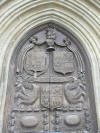 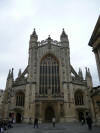  |
Bath Abbey (16th century) and the uproarious school children |
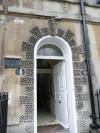   |
Jane Austen's Bath home 4 Sydney Place Pretty skies outside |
With much of the day left, we were off to Bradford-on-Avon so I could have a look at a very old little church, the St. Laurence. Built in 1001, it has remained well restored through all of these centuries and was a good excuse to stretch our legs around the town.
  |
St. Laurence church (built around 1001 AD) Water basin still remains |
  |
Intricate carvings and stone angels above the door |
After my few indulgences, it was Gerson's turn to find an oddity to visit. The Uffington White Horse has been traced back about 2,000 years and is a unique image carved into the hillside. Much like the Nasca lines in Peru, the chalk horse was "drawn" so that it could only be seen and recognised from the air, thus perpetuating the mystery of why it was created.
What I found more interesting was our lengthy trek under unnervingly rumbling skies that threatened to break open at any minute. Fortunately, the sky gods were forgiving and our California-weather luck travelled with us.
As the day was getting on and we started to look for a place to land for the night, I was intrigued (or should I say, in quite a sniggering state) when I saw the name of a particular city on the map. Keeping in mind that over the past few weeks we have looked at enormous castles and erect towers built by men who wanted to display their egos, so why not just create an entire town to accentuate what is most important to a man. Now you can see the reason why I was chuckling when I found the town of "Lacock" on my map.
As it turned out, ego or no, this town deservedly can boast that it is truly an untouched 18th century gem that took us completely by surprise in its beauty and in its character. Now, by character, I mean that in two respects: the character of the structure of the town itself and the character of a particular individual that unhesitatingly tried to convince us that he was the bastard grandson of the one and only Sir Winston Churchill.
David is the owner of Lacock Pottery, a conglomerate of potters that sell through David's shop that also has a homely Bed and Breakfast attached. Upon an immediate greeting by "Slip", the rather nonplussed cat that ruled the home, David began to throw out hints as to his parentage and more importantly, his grand-parentage.
I chose to gently rebuff his attempts for me to take the bait and told Gerson I would wait to see what happened at breakfast when he has us as his captured audience. We were able to sneak out for dinner at a terrific pub that has been serving meals consistently since the 1600's. We enjoyed our meal and atmosphere so much that we bought an etching of the town right off the wall of the pub.
The next morning, we awakened to the smell of the upcoming "full" breakfast and we sat patiently waiting to see what conversation would arise. Without disappointment, no sooner than I had mouthed my last bite, did David meander into the subject that obviously had been plaguing him all night.
All it took was a smile from me (as my mouth was still full) and David launched into his story. (disclaimer: I am only repeating what I was told). Apparently, David's grandmother, a rather attractive woman, was working as a hotel maid in Ireland when Mr. Churchill (as he was then known), went to Ireland in order to arrange the selling of his property in order to cover a rather inconvenient chancing (gambling) debt.
It was during this visit that Winston became temporarily enamored with David's grandmother and even though she was married, she was swept up in his charms and fell into his bed. It was not until David's Father was near the end of his life that the "truth" of his parentage was exposed and David's family pursued the story.
David's family confirmed Mr. Churchill's trip to Ireland at the time his Father would have been conceived and as David bears a physical resemblance to Sir Winston, he is convinced that he is in fact, the grandson of Sir Winston Churchill and great-grandson of an American, Winston's mother, Jennie Jerome.
I will leave it up to you, the reader, to decide the truth of the matter ;-).
Now, if meeting Sir Winston Churchill's "grandson" was not enough or stepping onto the doorstep of the famed Jane Austen, we found out that Lacock has a bit of celebrity in and of itself. Because of the village's unique capture of the 18th century, the town has been used as the backdrop to many movies and television shows, some very noteworthy and popular.
From the BBC's exceptional "Pride and Prejudice" starring Colin Firth or to the excellent "Moll Flanders" starring Robin Wright Penn and Morgan Freeman to many British TV programs, this little hamlet has been shown prominently in the 'city' scenes.
(And, I must provide a spoiler alert here as when you view these pictures, you will witness a scene from a very famous movie before it has been released to the general public.)
We left Lacock with trepidation as we would have liked to have spent more time wandering the streets and alleys or rather, the streets that were alleys. However, it was time to head eastward and into the Stone Age and mysteries that will probably never be fully explained.
Our first stop was the West Kennet Long Barrow, touted as England's finest burial mound dating from around 3500 BC and measuring 104m by 23m (about 310 feet by 65 feet). The entrance is guarded by massive sarsens that are similar in nature to the stones found at Stonehenge.
Keep in mind, that like the pyramids in Central America that were built within a couple of centuries of the Egyptian pyramids (yet there is no evidence that the two cultures ever communicated), these barrows are very similar to mounds found in the mid United States (Ohio being a prominent location) and the Ohio mounds were built about 1000 years after these in England (and yet there is no evidence that the two cultures ever communicated...things that make you go "hmmmmm").
The West Kennet Long Barrow was just the appetizer for the feast of Stone Age meals we were to ingest this day. A short drive later, we were in the town of Avebury and found ourselves surrounded by what drew us to this particular area. Virtually everyone has heard of Stonehenge and the various "conspiracy theories" that mist over the stone circle; however, hardly any person knows of the nearby Avebury.
Avebury's site is larger, older and has many more of these monolithic stones raised upright to stand precariously on their narrow ends and literally enclose the small enclave. Again, why these stones that weigh several to many tons (some up to 20 tons!), were moved hundreds of miles just to be placed in a circle within a circle is still a mystery.
Unfortunately, as the "church" began to rise in power and along with this rise came the irrational fear of paganism, many of the stones were deliberately buried. In addition, before the locals realized the magnificence of the "architecture", many of the uprighted boulders were toppled and broken down to use as premium building materials.
At present, less than half of the stones remain; however, the layout is easily discerned and the over two kilometer walk around the site just makes you shake your head in wonder all the more. The Stone Circle has a diameter of 348m (about 1000 feet) and is one of largest stone circles in Britain. These stones are anywhere between 3m to 6m (about 9 feet to 18 feet) in length. The Avenue is a 1 1/2 mile road that is lined by 100 pairs of standing stones and they seem to connect a Sanctuary (that was found by excavating post holes and some stones in yet another circle) with the Avebury circle.
One whimsical story came out of the Avebury site as very few of the stones actually have names. A particular stone referred to as the "Barber Surgeon Stone" was named thus because when the toppled boulder was raised back into its upright position, a skeleton was found underneath. Alongside of the unfortunate man was equipment that suggested he was a medieval travelling barber-surgeon (as a scalpel-like tool and similar instruments were found).
  |
The Barber Surgeon Stone
Avebury Manor - built in the 16th century |
 |
This stone belongs in the nearby village of Lacock (OK, I just could not resist) |
Not to be outdone by the Stone Age, a more recent St. James Church (15th century) was built in the middle of town and worth a quick visit, not to mention some of the beautiful cottages and pubs that adorned several corners.
 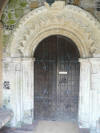 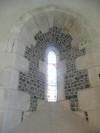 |
St. James Church and some of its intricate construction |
    |
Quaint cottages Cozy pubs and peaceful walkways The Sanctuary as marked by |
After Avebury, it was only a short jaunt to visit the awe-inspiring, almost eerie and tremendously famous, Stonehenge. Is Stonehenge some sort of astronomical clock or magnificent temple? Is it some space-alien landing port or some prank instigated by some Stone Age teenagers? It's a mystery that will probably remain for another 5000 years.
Built between 3000 BC - 1500 BC, Stonehenge was a horseshoe of stones within a circle within a circle, with some of the smaller bluestones (so named for their color before weathering into gray) weighing up to four tons. These crafted boulders were carried over 200 miles to their present position (coming from the Preseli Mountains in South Wales).
In addition, massive monolithic sarsens (a type of sandstone) were dragged from Marlborough Downs (about 20 miles away) only to erect them upright with equally impressive lintels to create trilithons (the formation of vertical and horizontal stones). These huge stones weighed up to 50 tons and it is estimated that it took 600 people to move just one of the stones across the country.
With the paid admission to the site, you are allowed to walk around the intimidating "temple", albeit at a roped-off distance. We were very fortunate as whilst we were there, very few people were on the trail with us. Only until the last quarter of the circular walk did we encounter the infamous busloads of tourists pouring over the grounds.
Between Avebury and Stonehenge, two equally powerful prehistoric sites, Avebury was the most fascinating. The freedom to walk around and right up to the stones at Avebury really gave you a sense of the enormity of the creation. However, Stonehenge, even from a distance, was an incredibly intimidating site and definitely gives the visitor a strange vibe.
Emerging from these lost worlds, we ventured into Salisbury for some new food in an old pub. Finding an eatery to our immediate liking (as the structure obviously had its rather tilted charms), we enjoyed a nice meal in a 14th century pub. Besides the good food, we found ourselves entertained by the severely sloping floors, precariously low ceilings and stunted door ways and especially, the mummified hand with playing cards embedded in one of the walls. Apparently, during some recent past repairs, the workers came across the 200 year-old mummified hand and cards and realizing its attraction, encased the site behind glass.
Not being ones to waste daylight, we made our way uphill to a place called Old Sarum, an Iron-Age hill-fort built around 1100 AD. After the buildings were dismantled in order to provide construction materials for the walls of Cathedral Close, only the rocky foundations remain and yet, these skeletons of what was once there still outline a tremendous fortress overseeing the town of Salisbury.
From the Stone Age to the Iron Age to the Modern Age, we made our way further East and found ourselves in Brighton and at the doorstep of a good friend, Bella. I met Bella in 1997 whilst travelling in Fiji and even though we only spent a few days together, our friendship was immediate and obviously, long lasting.
Bella has an excellent flat in close proximity of the beach and the enticing downtown area and we were so happy to have a place to wind down for a couple of days. But then, our winding down is getting up a little later and returning from our wanderings a bit earlier. We still made the most of the day with a pleasing trip along the south coast and into Rye.
  |
Gerson and Bella at Beachy Head
Something about living on |
    |
Amazing cliffs near Beachy Head and unspoiled views |
As Rye was our ultimate destination for the afternoon, we spent more time walking the streets then touring the restored historic sites that we found along the way. We did, however, stop into the city of Battle and its Battlefield and Battle Abbey as this area was the site of an important defeat of an English King (King Harold in 1066) by a French duke (William of Normandy). What is rather odd is that the English celebrate this defeat, so one would be led to believe that the King was not very popular.
Rye itself is a picturesque little town as it seems to be the epitome of the old English village. The town is filled with timbered Tudor buildings, winding cobbled streets and strong literary and artistic associations. As such, while we were there, there were a number of German school children frisking around town and sketching various structures and statues.
A remarkable note about this area are homes that are called Oast Houses. These "houses" were once giant, housed kilns for drying hops, which we should all know by now are a main ingredient in the brewing of beer. The Oast house was usually made up of four rooms and those being the kiln (oven), the drying room (located above the kiln), the cooling room and the storage room (where the hops were pressed and baled).
The cone shaped roof was necessary so that a draught would be created for the fire. The cowls located at the tops of the "cone" would move to regulate the airflow to the fire. Now, these Oast Houses have been converted to homes and are quite interesting and definitely unique to say the least.
We lazily made our way back to Brighton, and along the way, stopped off to view the Long Man of Wilimington. The creation of this 70m (about 200 feet) man is still a mystery and is easily viewed while driving along the nearby road. In addition, we concluded our afternoon with a stop at a hilltop viewpoint that let us take in the superb lands near Brighton.
Our second day was all about Brighton as we stayed close to "home". We set out for the Royal Pavilion, a lavish and hedonistic building constructed by the Prince Regent (only to later become King George) and primarily used for his own self-indulgence. The exterior is a combination of Moorish and Indian architecture, whereas the interior is infused with Chinese decoration. With one-ton chandeliers, massive rooms and a ceiling the boasts 26,000 scallop-shaped shells lit up by nine lotus-shaped chandeliers, the "palace" is a magnificently chaotic.
After our digesting the overwhelming visual feast of the Royal Pavilion, we walked the lovely streets, and even though the weather was threatening to hamper our day, we managed to brace against the chill wind and enjoy a jacket-clutched stroll along the Brighton Pier. And, in keeping with the English tradition, we found a little Tea shop wherein we enjoyed a "Cream Tea" with Bella. A "Cream Tea" is a little pot o' tea with a large scone heaped with real cream, butter and jam and oh!, is it delicious.
Sadly saying our good-byes to Bella, we pointed our rental car due north and headed back to Scotland, via Manchester. On the way, I could not resist the opportunity to follow in the footsteps of a man that I strongly admire, the steps of Sir Winston Churchill (of course, after meeting his grandson, anything else was a lesser experience :-)).
We were off to Woodstock, home of Blenheim Palace and home of the Churchill family. The palace was a gift to John Churchill, Duke of Marlborough for a job well done in defeating the French at the Battle of Blenheim in 1704. Although Sir Winston's father was a relative of the descendents of the Duke, he spent many years visiting Blenheim, proposed to his wife there and was buried at a small church in nearby Bladon.
And, as being so close to where Sir Winston was buried, we took a moment to visit this remarkable man's resting place. Sir Winston had requested that he receive no special attention for his grave and his original tomb was very plain and simple. In later years, a well-meaning group raised the money and had his grave redesigned with a white marble slab, yet keeping it relatively simple. Sir Winston Churchill is buried next to his wife, Clementine, and flowers grace his grave even today.
  |
Inside the small chapel in Blenheim Palace A colorful chicken lunch |
  |
Bladon Church and Sir Winston Churchill's grave |
Our last stop before Manchester was to Stratford-Upon-Avon, or rather the birthplace of one of the most famous playwrights in the world, William Shakespeare (1564 - 1616). We visited the dramatist's birthplace and walked the streets of this now touristy town, dodging in and out of people's pictures of anything Shakespeare.
    |
William Shakespeare's birthplace
Again with the short doorways |
 |
Gerson being a bit of a clown himself |
My cousins, Chris and Adrian were a welcome sight that evening and we were looking forward to spending a couple more days in their happy company. Fortunately, the next day the weather behaved and Adrian and Chris took us to the Quarry Bank Mill located just outside of Manchester.
The Quarry Bank Mill is an 18th century cotton mill that is managed by the National Trust. It was a fantastic tour through a period of time and many of the hundred's of years old machines still perform their cotton-thread-making and cloth-weaving duties for which they were designed.
Home Page
United Kingdom Diary Index
Previous Diary Page 3
UK Diary Page 5